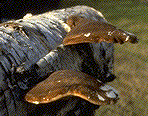Archived Content
Information identified as archived on the Web is for reference, research or recordkeeping purposes. It has not been altered or updated after the date of archiving. Web pages that are archived on the Web are not subject to the Government of Canada Web Standards. As per the Communications Policy of the Government of Canada, you can request alternate formats on the Contact Us page.
Brown Cubical Rot of Birch
Piptoporus betulinus (Bull.:Fr.) P. Karst.
(= Polyporus betulinus (Bull.:Fr.) Fr.)
Basidiomycotina, Aphyllophorales, Polyporaceae
Hosts:Piptoporus betulinus is restricted to birch; white birch in B.C. and yellow birch elsewhere.
Distribution: This fungus is found throughout the range of birch in the province.
Identification: The fruiting bodies are annual, leathery, with a short, stout stipe, and a cap up to 15 cm deep, x 25 cm wide x 6 cm high (Fig. 23a). The upper surface is light brown, becoming darker brown and scaly, with a margin that extends below the pore surface. The pore surface is white, becoming light brown and slightly tooth-like with age (Fig. 23b), pores circular, 3-5 per mm. Context white, easily separating from tube layer when fresh.
Decayed wood is yellowish-brown and cracks into cubes with thin white mycelial mats forming in the cracks. Wood in advanced stages of decay is very light in weight and easily crumbles to powder.
Microscopic Characteristics: Hyphae in the context of the fruiting body of two types: thin-walled, hyaline with clamp connections, and thick-walled, aseptate Basidiospores cylindric, allantoid, hyaline, smooth, IKI-, 5-6 x 1.5-1.7 µm. Growth in culture moderately rapid, mat colourless to white, forming compact balls of mycelium on surface of medium, chlamydospore-like swellings, laccase negative. Stalpers: (6) (7) (12) (13) 14 17 19 21 (22) 30 (31) 80 83 (85) (88) 89 (93).
Damage:Piptoporus betulinus is often present in dead branches of dying trees. After trees die, rot develops in the bark and sapwood, and generally spreads to the centre of the trunk. Infected wood decays rapidly; laboratory studies have shown reduction of wood density of 30-70% in four months.
Remarks: Piptoporus betulinus is one of the few brown rotting fungi that only attacks hardwoods. Although it is restricted to birch hosts in nature, other tree species such as pine, spruce, and poplar have been successfully inoculated in lab and field experiments.
References:
Gilbertson, R. L. and L. Ryvarden. 1987. North American Polypores. 2:633. Fungiflora, Oslo.
Figures
Click on any image to see the full size version.
Press "Back" on your browser to return to this screen.

Figure 23a: Piptoporus betulinus fruiting body on a dead standing birch stem.
 Figure 23b: Older fruiting bodies on a fallen birch stem.
Figure 23b: Older fruiting bodies on a fallen birch stem.
 This Web page has been archived on the Web.
This Web page has been archived on the Web.